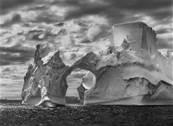
I am not a great fan of pictures. I rather prefer storing images in my own memory so that they can become part of me. Sometimes with a camera at hands, you end up wanting to capture every single image. With new smart cameras and mobile, yes there is an endless space to keep your memories.
The problem is that you end up capturing everything and nothing. Pictures risk to be futile….but not if you have the chance to admire the pictures of Sebastiao Salgado, one of the greatest living photographers in the world, probably the best living artist able to fully capture the soul and the essence of human sufferance. Human pain through the lens of Salgado, acquires, almost magically, some sort of dignity.
Currently in Singapore for a conference, I had the luck to attend a talk program with Salgado at National Singapore Museum where his latest project “Genesis” is on show.
As said by the author, before embarking in this project, everybody including his agents was worried about his choice to get involved and dedicate himself in a massive project focused on Mother Nature… shifting from “human” animals to other forms of animals, capturing the majestic and often incontrollable power of the earth in its most remote and wildest spots.
After all Salgado become a legend for his impressive ability to “posses” and translate the key essences of humanity by focusing on the most oppressed and marginalized.
A Brazilian who spent most of his life in a forced exile due to repression of the military regime in his home country, Salgado’s pictures are able to offer a voice to victims of famines, wars, repressions and natural disasters. Photography for Salgado is a platform to empower those hidden and forgotten; his images are capable of breaking down the walls of silence and indifference surrounding those at the receiving ends of globalization.
In Genesis, Salgado expresses his deep concerns against the risks of a modernization whose foundations are laid against nature. Coming from rural Brazil, Salgado saw firsthand how fast his country accelerated towards a path of growth at the expenses of the nature.
The pictures are from the most remote corners of our planet: Siberia, Antarctica, the Amazon forest, Papua New Guinea, Ethiopia, etc. The show proves that these inhospitable places of stunning beauty are home for human beings and other species alike since thousands of years. Modernization is not one way only and do not forget that there are others who are happy on their own.
All pictures are impressive and almost unimaginable: hard to realize that on earth there are still places of incredible beauties such as those framed by Salgado.
Is it possible to foster a path ahead where growth can be sustainable and inclusive? How to reconcile divergent interests when we plan economic and human planning? Interesting enough Genesis has been sponsored by Vale, one of the major global mining companies in the world. Hopefully this is not just a PR exercise but a real engagement in corporate sustainability.
Possibly Salgado is the best person able to show that a different planet is possible: a place where everybody is respected, where humans can co exist peacefully with nature.
A place where dignity becomes a reality; not just hypocrisy or a slogan of a campaign.
From the place where everything started, let’s start a new conversation about the development paradigm we want.
http://www.amazonasimages.com/










Add new comment